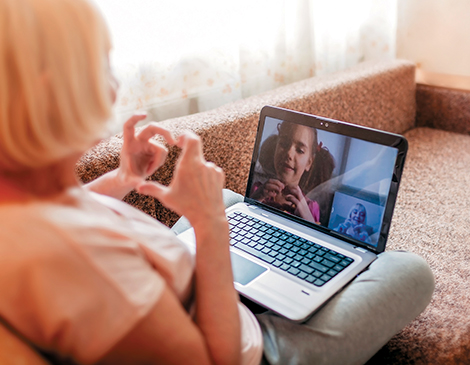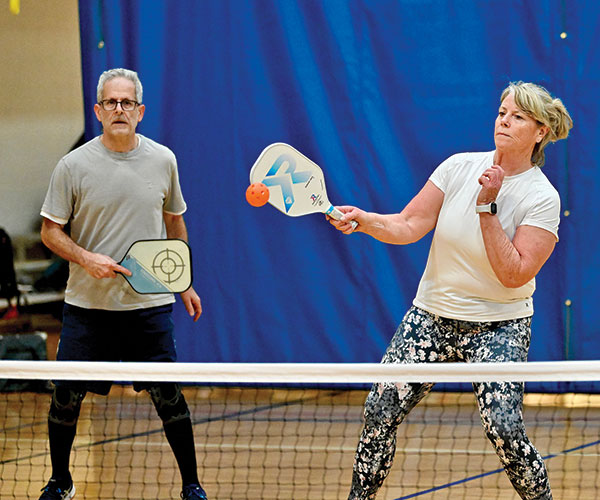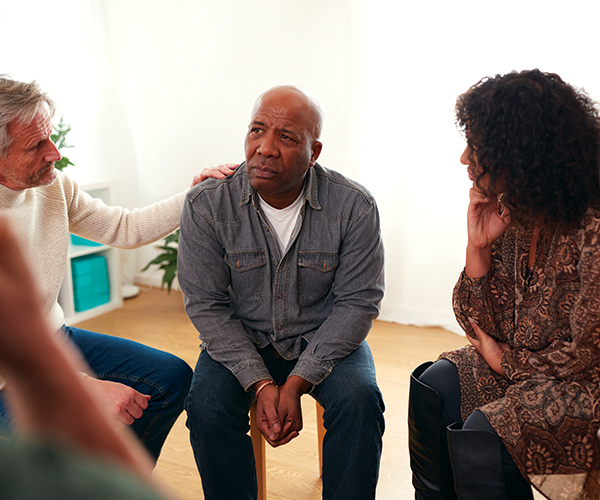A lively hallway game of Pokeno at Jennings retirement community in Garfield Heights draws a safely spaced group of avid players to their doors for some much-anticipated social time with friends that feel like family.
“We had quite a turnout!” exclaims Marjorie Vetalice, 87, who’s lived there for three years and looks forward to card games. “They set up our chairs in the hallway, and I used my walker to set the cards on. We used our hand sanitizer. I was amazed at how well it worked!”
She’s looking forward to an upcoming hallway bingo.
“It felt good,” Vetalice says. “It’s nice to see everyone — you just don’t want to get too close to each other.”
From FaceTime to neighborly waves with a good 10 to 20 feet of distance between residents, retirement living communities are finding ways to leverage technology and adapt programs so the “new normal” of social distancing doesn’t feel so isolating.
In fact, many are discovering that fresh ways of connecting are bringing residents, families and friends closer together than they were before.
Mary McKown, for example, navigates a smartphone from her apartment at Ohio Living Breckenridge Village in Willoughby, texting her grandchildren and monitoring social media occasionally.
“I just opened up my phone a bit ago and I have 60 requests for new friends,” she says.
At 94, McKown, who calls herself a “Depression baby,” says she is positive and hopeful.
“This makes you realize how valuable life is and what a gift we are given every day to be there for one another,” she says.
McKown finally retired from working part time in her son and daughter-in-law’s funeral home business at age 93. She enjoyed a 20- year career at General Electric Co. before that.
“I loved what I did, and that is the secret to life,” she says.
For McKown, spreading that lesson is vitally important, especially during a time when we are ordered to shelter in place.
“I walk the hall and go down to get my mail,” she says, adding that she stays a safe distance away, but offers warm hellos. “If I can raise someone’s spirits, that is what we are meant to do.”
The state orders to practice social distancing and shelter at home can be lonely for anyone. This is especially true for seniors who might depend on a periodic visit from a family member or friend. But retirement communities are stepping up with new ways to “visit” while adhering to Centers for Disease Control and Prevention and Ohio Department of Health recommendations.
“I’m most proud of how flexible and creative everyone is,” says Lisa Brazytis, chief marketing officer at Jennings Ohio. “There is a real sense of family here, and everyone is jumping in to help during a time that is scary, knowing we all have to be so careful.”
The message from retirement living communities is consistent.
“We’re paying attention to Gov. DeWine, to what the CDC is telling us and the Ohio Department of Health,” says Dean Palombaro, executive director at Breckenridge Village. “From there, we send communications to residents and families via email and print, along with our in-house TV station.”
Information access can create a sense of safety when it comes from a trusted source.
“The more we communicate to the team and our families, that makes them feel like, Alright, my mom, dad or loved one is in the right place,” Palombaro says.
Setting Limits For Health and Safety
In March, Breckenridge Village and most other senior living facilities cut off visitation to nursing and assisted living buildings.
“We banned visitation completely on our campus so we could stop people from coming in,” Palombaro says. “The process was terrible, not because of how we handled it, but because we had to keep loved ones from seeing their loved ones.”
Within a week of instituting the restrictions, news stories multiplied, and more families understood that the measures were critical for health and safety. At Breckenridge Village, where there are 677 living units ranging from brownstone homes and ranch-style houses to subsidized senior living, the four main roads entering its 55-acre campus were restricted to two access points. Health screening checkpoints were installed at those entrances.
“Regardless of who you are, you are screened for temperature, cough, shortness of breath, and if you don’t pass the screening, we send you home,” Palombaro says.
The campus has full-time security personnel, but other staff members who are displaced, such as occupational therapists, who are not conducting one-on-one visits now, have stepped in to help at the checkpoints.
“We have an infection preventionist on staff who did in-service training with our staff, so everyone is trained and it’s all hands on deck,” Palombaro says.
Employees must pass through the checkpoints on the way in to work, and the same goes for delivery trucks bringing in food and supplies. The campus added a third pantry, which allows residents to shop for essentials without leaving the Breckenridge Village community.
“We bring the essential items here so they can buy them just like they would at the grocery store and they don’t have to go out,” Palombaro says.
Brazytis echoes the conservative approach in Jennings’ visitation practices.
“We have given our residents and families guidelines,” she says, noting that those living independently on campus are receiving only critical visits.
Whether they’re living in an apartment or at their homes, many rely on resources such as home health care or delivered meals.
“So, we have talked to them about only having those critical visits,” Brazytis says. “Or one family member who comes to visit, and it’s very clear that the person has a responsibility to keep that independent loved one healthy.”
Meanwhile, Jennings is giving families a way to brighten the days of residents living on campus. It recently moved its gift shop online.
“Families can send little care packages of candies or toiletries to their loved ones,” Brazytis says.
At Judson Senior Living, a dedicated webpage was developed to outline the organization’s response to COVID-19. Residents’ families and friends could visit the page, learn and sign up for email updates, says president and CEO Kendra Urdzik.
“We’ve made personal phone calls to families or emergency contacts for every resident to make sure they know where to go for information,” she adds.
Judson also launched a COVID-19 Call Line for residents and families who have non-clinical questions, feedback or need assistance.
“We are continually assessing our communications to find ways we can improve,” Urdzik says. “Everyone is so very connected here. Truly, there are so many groups that come together here all the time, so when we had to no longer allow visitors on our campus, it made it even more important for our community to come together in other ways.”
Making New Connections
Most are using virtual methods to connect, but some are more personal, knocking on doors and saying hello from a distance or making a phone call to a family member who is waving outside a resident’s window.
“I do a little bit of door knocking,” says McKown, adding that she walks the hallways daily to get some exercises since group wellness classes have come to a halt for the time being. “I’m really social, and even though we are told to stay in our homes, we have to be positive — and if a door is unlocked, I will knock and say, ‘Hi, thinking of you, and stay well,’ ” she says.
Judson, which usually has programs that let residents interact with cultural institutions near University Circle, built a partnership with the Cleveland Children’s Museum to encourage communication across generations.
“We will encourage our members and visitors to have their children and families create cards, photos and art to share digitally with Judson residents,” says Hattie Kotz, the museum’s director of marketing and development.
The museum has about 7,000 members and sees 200,000 visitors annually.
“We thought this would be a great collaboration, considering the situation we are all in, for us to virtually connect our families with the families Judson serves,” Kotz says.
Laurel Hopkins Larson, a museum member, says she’ll be encouraging her children to share a slice of their lives with residents at Judson.
“It is a pleasure to encourage our children to be creative, show empathy and do something kind to bring a moment of joy to someone who needs it,” she relates.
Urdzik says Judson will share the partnership on its website, social media and in daily updates.
Meanwhile, some interactions can stay in place. For example, Judson will continue performances from its Artist-in-Residence program, where students from Cleveland Institute of Music live in the buildings and share their talents as “rent.” Student artists will play music in the hallways for residents to enjoy.
Rather than its Friendly Visits program, which encourages resident volunteers to visit other residents on campus, Judson adapted the Friendly Calls initiative, using telephone chats to check in. The Very Rev. Tracey Lind, formerly of Trinity Cathedral in Cleveland, has been making video calls to residents to offer conversation and inspiration.
Plus, a Hallway Holler event allowed residents to open their doors, step into the hallways during designated times and visit with each other from a safe distance.
“Someone could become very isolated in their apartment, or even confused with so much going on — they can feel overwhelmed by the world around them, especially if you are sitting in front of the TV all day,” Urdzik says. “So, this level of connectivity is very important. We are connecting in different ways that feel safe, secure and help everyone realize they are not alone while we are trying to keep them safe and healthy.”
From FaceTime to Meal Delivery
For the tech-challenged, a communication concierge at Jennings sets up FaceTime calls between residents and their loved ones. And at Breckenridge Village, the community purchased a dozen more iPads to use for the same purpose.
At Danbury Senior Living, staff is stepping up and out of their usual roles to help residents navigate technology or to simply have a conversation.
“I watched one of our staff members today help one of our residents connect with a family member in Texas and a niece in North Carolina,” says Dan Huckins, director of leadership and communications at Danbury Senior Living. “Some really great connections are happening.”
Urdzik comments that some Judson residents are tuning in to Zoom video calls to meet with family members who are dispersed across the country.
“Their entire family is in front of them connecting at one time, just sharing together,” she relates. “We’re coming up with so many creative ways to connect.”
Communities are also adapting how they deliver meals with closed dining rooms and restaurants. At Breckenridge Village, this means serving 780 residents individually in their rooms.
“We had to make adjustments to the menu and limit options, so there is one dinner option that goes out every night,” Palombaro says. “And we have gotten no complaints whatsoever.”
Some residents who live independently were not previously getting meals, but now the culinary staff is offering dinner nightly.
Meanwhile, education continues as communities provide information to residents to help protect their health, physically and spiritually.
The internal TV station at Breckenridge Village has expanded its chapel channel to include guided meditation.
“We have some team members who are yoga or fitness instructors, and they are putting together instructional videos on wellness and exercise so residents can work out in their apartments or homes,” Palombaro says.
Notably, staff at these communities have worked tirelessly to keep residents safe and have adapted to new roles, filling in where needed so they can help residents connect and manage daily activities with the COVID-19 restrictions.
“Staff is rising to a new challenge and working together as a team, even as things are changing so rapidly,” Brazytis says. “It takes a family.”




